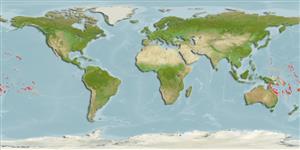>
Acanthuriformes (Surgeonfishes) >
Acanthuridae (Surgeonfishes, tangs, unicornfishes) > Acanthurinae
Etymology: Acanthurus: Greek, akantha = thorn + Greek, oura = tail (Ref. 45335).
Eponymy: Achilles was the mythical Greek hero of the Trojan War. His only vulnerable spot was his heel (hence ‘Achilles’ heel’). The tang has a (roughly) heel-like mark on its body. (Ref. 128868), visit book page.
More on author: Shaw.
Issue
Distribution to be checked.
Environment: milieu / climate zone / depth range / distribution range
экология
морской ассоциированный с рифами; пределы глубины 0 - 10 m (Ref. 27115), usually 0 - 4 m (Ref. 9710). Tropical; 28°N - 26°S, 143°E - 109°W
Western Pacific: oceanic islands of Oceania to the Hawaiian and Pitcairn islands. Also known from Wake, Marcus, and Mariana islands. Eastern Central Pacific: southern tip of Baja California, Mexico (Ref. 9267) and other offshore islands.
Size / Вес / Возраст
Maturity: Lm ? range ? - ? cm
Max length : 24.0 cm TL самец/пол неопределен; (Ref. 9710)
колючие лучи спинного плавника (общее число) : 9; членистые (мягкие) лучи спинного плавника (общее число) : 29 - 33; колючие лучи анального плавника: 3; членистые (мягкие) лучи анального плавника: 26 - 29. Dark brown, nearly black in color. Erectile spine (sharp and forward-pointing) on each side of caudal peduncle which folds down into a groove. Mouth small, snout noticeably extended. Light blue ring around chin and presence of spot of same color on gill cover at angle of gill opening. Dorsal fin with soft part having longer base than spinous part. Juveniles lack the large orange spot on caudal area.
Occurs in clear seaward reefs, usually in groups (Ref. 9710). Benthopelagic (Ref. 58302). Feeds on filamentous and small fleshy algae (Ref. 9267). Monogamous (Ref. 52884). Spine in caudal peduncle may be venomous. Size of metamorphosis from postlarva stage to juvenile is 6 cm (Ref. 9267). This species sometimes hybridizes with A. nigricans (Ref. 9808).
Life cycle and mating behavior
половая зрелость | размножение | нерест | икра | Fecundity | личинки
Monogamous mating is observed as both facultative and social (Ref. 52884).
Randall, J.E., 1956. A revision of the surgeonfish genus Acanthurus. Pac. Sci. 10(2):159-235. (Ref. 1920)
Статус Красного Списка МСОП (Ref. 130435: Version 2024-1)
Угроза для людей
Traumatogenic (Ref. 4690)
Использование человеком
рыболовство: коммерческий; аквариум: коммерческий
дополнительная информация
инструменты
Специальные отчеты
Скачать в формате XML
ресурсы в Интернет
Estimates based on models
Preferred temperature (Ref.
123201): 25.8 - 28.3, mean 27.4 °C (based on 404 cells).
Phylogenetic diversity index (Ref.
82804): PD
50 = 0.5000 [Uniqueness, from 0.5 = low to 2.0 = high].
Bayesian length-weight: a=0.01995 (0.00906 - 0.04395), b=3.01 (2.83 - 3.19), in cm total length, based on all LWR estimates for this body shape (Ref.
93245).
Trophic level (Ref.
69278): 2.0 ±0.00 se; based on food items.
устойчивость к внешним воздействиям (Ref.
120179): высокий, минимальное время удвоения популяции до 15 месяцев (Preliminary K or Fecundity.).
Fishing Vulnerability (Ref.
59153): Low vulnerability (14 of 100).
Nutrients (Ref.
124155): Calcium = 77.7 [33.7, 236.7] mg/100g; Iron = 0.837 [0.317, 2.103] mg/100g; Protein = 18.2 [16.9, 19.4] %; Omega3 = 0.0938 [, ] g/100g; Selenium = 13 [4, 39] μg/100g; VitaminA = 45.8 [10.8, 181.2] μg/100g; Zinc = 3.17 [0.99, 6.04] mg/100g (wet weight);
